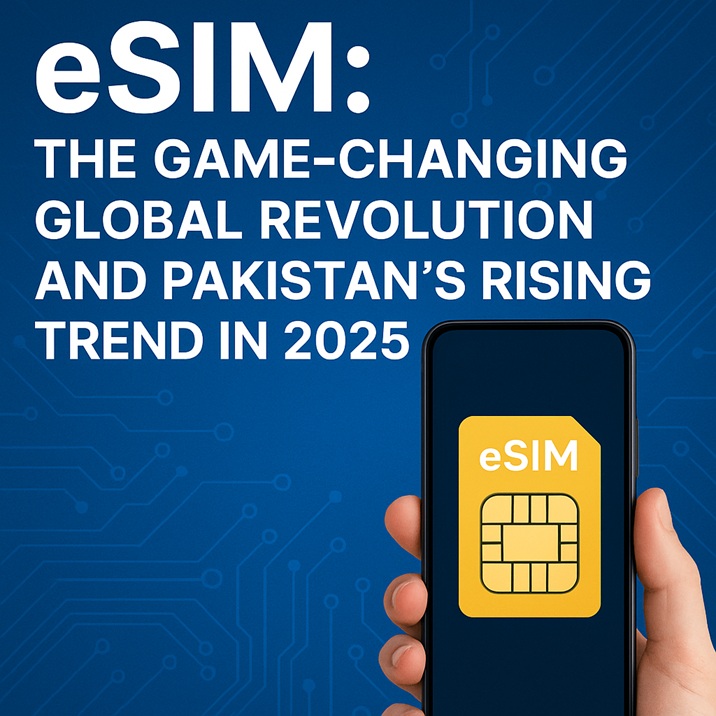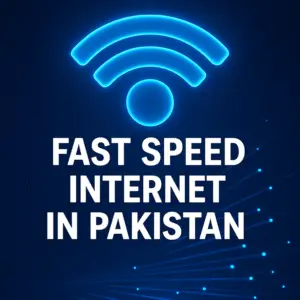eSIM: The Game-Changing Global Revolution and Pakistan’s Rising Trend in 2025
Introduction
Have you ever found yourself fumbling with a tiny SIM card, trying to insert it into your phone while hoping you don’t damage it? Assume a future where changing your mobile carrier is as easy as pointing your phone at a QR code.. That’s the world eSIM technology promises, and it’s heading to Pakistan faster than you might think.
In 2025, eSIM—short for embedded SIM—is set to transform how we connect to mobile networks. Whether you’re a student, a traveler, a business owner, or just someone tired of waiting in line to get a SIM card replaced, eSIM technology could make your life a whole lot easier. But what is it really, and why does it matter now more than ever? Let’s explore the story of eSIM in Pakistan and what lies ahead.
Table of Contents
What exactly is an eSIM and how does it function?
Short for embedded SIM, it’s a built-in chip that replaces the need for a physical SIM card. Unlike the physical SIM cards we’re all used to, an eSIM is built directly into your phone or device. You can’t remove it or lose it, and best of all, you don’t need to physically replace it when you change networks.
Instead, you simply activate a new mobile plan using your phone’s settings or by scanning a QR code. This makes switching between networks and managing mobile data plans much easier and quicker. It’s like moving from CDs to streaming services—faster, more convenient, and less prone to errors.
The Rise of eSIM Globally and in Pakistan
The eSIM trend emerged globally in 2010 in the IoT market and gained traction in the consumer market in 2016. In Pakistan, Jazz was the first telecom operator to introduce eSIM support, starting in 2019. Ufone followed suit in February 2021. Later in 2023 ZONG joined the race.
Pakistan continues to welcome innovative tech advancements, and the use of eSIM technology is steadily becoming more widespread nationwide. To understand how far mobile communication has come in Pakistan, from the days of analog voice calls to today’s digital innovations, check out our blog on The Surprising Evolution of Mobile Communication. In major cities like Karachi, Lahore, and Islamabad, tech enthusiasts are already switching to eSIM-compatible devices.
The trend is being supported by global smartphone brands such as Apple, Samsung, and Google, which have introduced eSIM support in their latest models.
Why 2025 Is a Pivotal Year for eSIM Adoption
The year 2025 is shaping up to be a game-changer for eSIM adoption in Pakistan. Several factors are aligning at once. More affordable eSIM-compatible smartphones are entering the market, making the technology accessible to the average consumer. Telecom operators are upgrading their infrastructure to support eSIM activations across all regions, building on the advancements in high-speed internet connectivity. To learn more about how Pakistan is improving its internet speeds and connectivity, check out our blog on Fast Internet in Pakistan.
Public awareness is also expected to rise due to increased marketing efforts by telecom companies and device manufacturers. The convenience, efficiency, and potential cost savings are likely to attract a significant number of users. With the right mix of market preparedness, cost-effectiveness, and rising interest, 2025 is shaping up to be a landmark year.


How eSIMs Benefit Everyday Users
The biggest advantage of eSIM technology is its simplicity. Imagine being able to change your mobile network in minutes without visiting a service center. That’s the power of eSIM. It saves time, removes the hassle of carrying multiple SIM cards, and offers peace of mind since you can never misplace it.
For users who travel frequently, the benefit is even greater. You can activate a local mobile plan in another country directly from your phone, avoiding expensive roaming charges and the inconvenience of buying foreign SIM cards. It’s like upgrading from a clunky keyring to a digital smart lock—modern, efficient, and user-friendly.
eSIM vs Traditional SIM: A Simple Comparison
While traditional SIM cards require manual insertion and are prone to damage or loss, eSIM is built into your device and doesn’t need any physical handling. Conventional SIM cards require physical replacement when changing carriers, a process that can be both inconvenient and slow. In contrast, eSIM allows you to switch between mobile carriers almost instantly through digital means.
The traditional SIM is more limited when it comes to dual-network usage, whereas eSIM can support multiple network profiles on the same device. For most users, the convenience and flexibility of eSIM far outweigh the old methods.
What Telecom Companies Are Doing Differently

Leading telecom operators in Pakistan—such as Jazz, Zong, and Ufone—are each exploring unique strategies to roll out eSIM solutions. All of them are offering eSIM activation for high-end smartphones.
These companies are also partnering with smartphone brands to offer bundled packages and exclusive offers for eSIM users. In the coming months, we can expect more announcements, greater coverage, and promotional campaigns aimed at making eSIM a mainstream option.
The Role of Smartphones and Wearables
The adoption of eSIM is closely tied to the rise of modern smartphones and smart wearables. Manufacturers like Apple and Samsung are already producing devices that either support or depend entirely on eSIM technology. This trend is expected to continue, with new devices coming equipped with eSIM as standard.
eSIM technology is expanding beyond mobile phones, now being adopted by gadgets like smartwatches, tablets, and even laptops. These gadgets can stay connected to mobile networks without needing to tether to a smartphone. As more people embrace these devices, the demand for eSIM will naturally rise.
Impact on Travel and International Roaming
Frequent travelers often struggle with the inconvenience of swapping SIM cards or facing steep international roaming fees. eSIM eliminates this by allowing users to download and activate a local mobile plan even before they arrive in another country.
This is especially beneficial for professionals who travel for work or students studying abroad. It simplifies communication, reduces costs, and makes staying connected more reliable and hassle-free. For global travelers, it represents a significant upgrade in mobile flexibility and ease of use.
How eSIM is Shaping the Future of IoT and Smart Tech in Pakistan
eSIM is not just for phones. It plays a vital role in the future of smart devices and the Internet of Things (IoT). Devices such as smart meters, surveillance systems, connected cars, and industrial sensors can all benefit from eSIM’s remote management capabilities.
In Pakistan, the integration of eSIM into IoT devices can support smart city projects, improve logistics, and enhance security systems. With no need for physical SIM swaps, managing large networks of devices becomes far easier and more efficient.
Challenges Facing eSIM Adoption
Despite its many advantages, eSIM adoption in Pakistan faces a few hurdles. Not all smartphones currently support the technology, especially in the budget segment. As a result, a large segment of the population remains unable to take full advantage of this technology.
Additionally, many users are still unfamiliar with how eSIM works, and some telecom staff may not be fully trained to support it. There’s also the matter of initial setup costs, which could deter first-time users. However, as awareness spreads and technology becomes more affordable, these challenges are expected to fade.
Government Policies and Regulatory Outlook
New technologies often gain traction faster when government initiatives and support are in place to drive their growth. The Pakistan Telecommunication Authority (PTA) is currently developing guidelines to manage eSIM activations securely. These include integrating eSIM registration with national ID systems to prevent fraud and streamline the activation process.
Future regulations may also mandate telecom providers to offer eSIM as a standard service, ensuring fair access and consistent user experiences across the country.
Privacy and Security: Is eSIM Safer?
What makes eSIM technology especially comforting is the strong layer of security it offers. Because the SIM is built into the device and activated digitally, it is much harder to clone or misuse.
If a device is lost or stolen, users have the ability to either remotely disable their eSIM or move it to a different device, reducing potential security threats. Encryption protocols also make eSIM activation more secure than traditional SIMs, offering peace of mind to users concerned about privacy and data safety.
How to Get Started with eSIM in 2025
Getting started with eSIM is easier than it might seem. Start by confirming whether your device is compatible with eSIM functionality. This information can usually be found in your phone settings or manufacturer’s website. Next, visit your mobile provider and request an eSIM profile. They’ll guide you through scanning a QR code or using their app to activate the service.
Once activated, you’re good to go—no SIM swapping, no waiting, just instant connectivity.
The Future of eSIM: Beyond Mobile Phones
As we look ahead, the influence of eSIM will extend well beyond mobile phones. Cars with real-time GPS updates, homes with smart lighting and security, and even health devices that send real-time vitals to doctors will all rely on eSIM for connectivity.
The idea is to create a seamless digital ecosystem where devices talk to each other without physical barriers. Pakistan’s increasing interest in smart infrastructure and digital innovation makes it fertile ground for this transformation.
Final Thoughts: Embracing the eSIM Era
eSIM isn’t just another tech buzzword. It represents a major shift in how we think about mobile connectivity. By 2025, it has the potential to become the standard for personal and professional communication in Pakistan.
If you’re planning your next device upgrade or looking to streamline your digital life, consider embracing the eSIM technology. The future of connectivity is embedded, invisible, and incredibly powerful—and it’s just around the corner.
eSIM Trend in Pakistan.
The eSIM trend in Pakistan is gaining momentum as digital connectivity evolves. All three major telecom operators—Zong, Jazz, and Ufone—now offer eSIM services, allowing users to activate cellular plans digitally without physical SIM cards. This shift enhances convenience, supports multiple profiles on a single device, and aligns with the growing adoption of smart devices, making Pakistan’s telecom market more flexible and user-friendly.



Frequently Asked Questions (FAQs)
1. Can I use eSIM in Pakistan right now?
Yes, several telecom providers in Pakistan have already started offering eSIM services for supported smartphones.
2. What devices are compatible with eSIM?
Devices such as iPhones from the XS series onwards, recent Samsung Galaxy models, and Google Pixel phones support eSIM. Check with your manufacturer for details.
3. Does eSIM technology offer better security compared to traditional SIM cards?
Absolutely, eSIM uses stronger encryption methods and is much more difficult to duplicate or exploit. It also allows remote deactivation if your device is lost or stolen.
4. Do you need to be connected to the internet to activate an eSIM on your phone or gadget?
Yes, you need internet access to download and activate your eSIM profile using a QR code or mobile app.
5. Will traditional SIM cards disappear completely?
Not immediately, but over time, traditional SIM cards are likely to be phased out as eSIM becomes the new standard.
References
- Pakistan Telecommunication Authority (PTA)
www.pta.gov.pk
Official updates and regulatory framework for telecom technologies including eSIM, spectrum allocation, and mobile device policies. - GSMA – The Global System for Mobile Communications
www.gsma.com/esim
Industry-standard body providing detailed resources and insights on global eSIM adoption, specifications, and operator readiness. - Statista – eSIM Market Forecast 2025
www.statista.com
Provides projections for eSIM users, global market penetration, and Asia-specific adoption rates. - ET Telecom (Economic Times – Telecom Division)
telecom.economictimes.indiatimes.com
Reports on regional developments in South Asia including Pakistan, such as telecom operator partnerships and eSIM rollout news. - Business Recorder Pakistan – Tech and Telecom News
www.brecorder.com
Offers updates on technology advancements in Pakistan, including eSIM implementation by local telecom operators. - Jazz and Zong Official Websites
www.jazz.com.pk | www.zong.com.pk
Local telecom providers offering eSIM support in Pakistan. Official details on compatibility, activation process, and coverage. - Qualcomm eSIM Technology Overview
www.qualcomm.com/products/esim
Explains the chipset-level support for eSIM in mobile devices, which is crucial for understanding device compatibility in the region. - GSMA Intelligence – eSIM Consumer Insights
www.gsmaintelligence.com
In-depth research reports on consumer behavior, adoption trends, and regional variations in eSIM demand.



